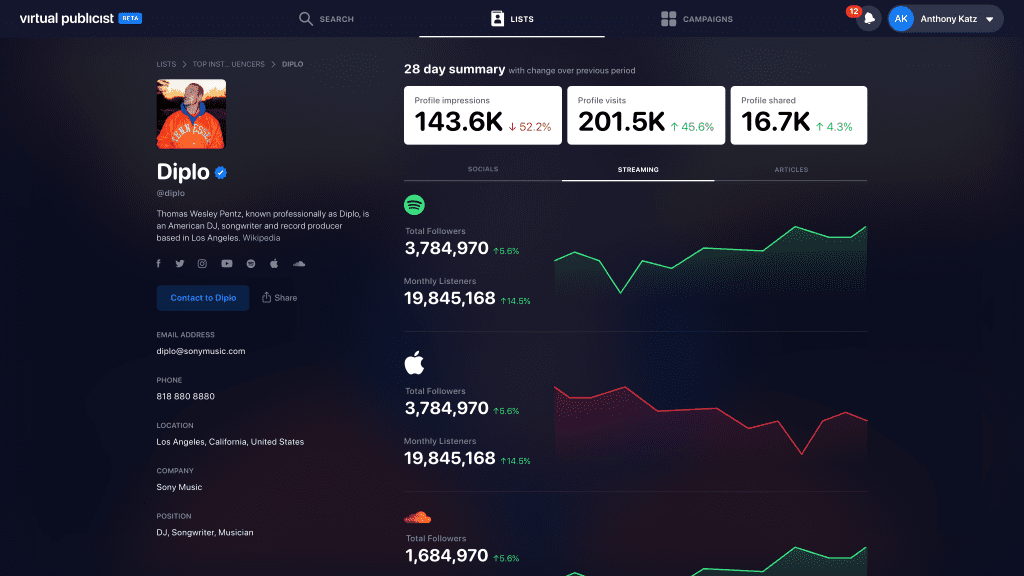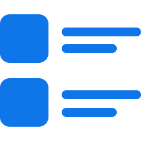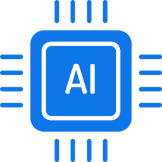Music Data Analytics:
The New Way Of Using API
- Music data analytics are the cornerstone of your career strategy. They help you understand how your brand exposure is progressing as you interact with the media and get your story out there.
- How to Connect Your Socials to start your Music Data Analytics
- Profile Settings are essential for Music Data Analytics
How to Connect Your Socials to start your Music Data Analytics
Connecting your social networks is a fundamental part of the Virtual Publicist experience.
By having all of your platforms feed your new publicist, you can track your progress in relation to the overall industry rather than from a single vantage point. Receive strategic paths to success that will help you visualize the step-by-step process of reaching the top.

To connect your socials:
- Log in to your Virtual Publicist account and click on Profile And Settings.
- On the account page, navigate to the Link Social Profiles section.
- From here, copy and paste your profile link in each section and click connect.
To avoid bugs or delays, connect them one at a time. - Easily connect all your social media accounts including:
Facebook
Instagram
Twitter
Soundcloud
YouTube
Spotify and more. - Once your profile is linked, you will receive updates on your analytics or insight regularly on a weekly report.
If you want to modify the frequency of your reports simply modify them in the settings section.
Having all your social media profiles in one place gives you the professional look you need to attract and convert top outlets to your profile. It will also increase your authentication factor making your profile more probable to be verified on other social platforms.
To read more about profile authentication check out our page – here – for more details.
For more Pro Tips about messaging, pitching, and selective language suggestions check out our blogs on
To get a headstart on Virtual Publicist, let’s first fill out your profile with all the relevant information.
Profile Settings are essential for Music Data Analytics
Start with:
- Name:
- This is your personal profile name, it will only be visible to those you allow to see. This name will be at the bottom of the signature when sending emails unless you change it in your privacy settings.
- Username:
- this is the name other profiles will see when you are communicating with them unless you choose to use your profile’s real name.
- Email:
- This is your official email connected to the Virtual Publicist account. You will be receiving all updates, reports, & responses from outlets here.
- Location:
- Select the area where you carry out your musical career
- Even as an online vendor, your profiles are attached to a geographic region or location. This will help identify your profile’s needs in terms of regional partners that will help you scale.
- If your base of operations is decentralized, say, as a digital nomad, indicate the location your other social profiles are under so that the profiles can be matched to your Virtual Publicist account.
- This location will also help those that want to collaborate with you to know where you are and how they can reach you if ever they are to meet you in person.
- Select the area where you carry out your musical career
Customization:
Now that we have identified your first layer of data, it is time to get down to the fun details.
Profile picture:
To add a profile picture select edit your profile by clicking the edit button in the settings sections. If you want to speed up authentication processes add the same profile picture as you have on other platforms so that we can recognize it faster.
You can also choose to edit your username by clicking the pencil icon next to your name and making it into your own unique signature.
Tags & Genres:
In the Personal Information section, there is a sub-section on the left indicating genres & tags. Fill in the accurate information about yourself and your work so that the Virtual Publicist can properly curate the content you need most.
- Genres:
- You can select a maximum of 3 genres to define your music. You can change the definition of your genre every 3 months so choose wisely.
- Pick 2 general genres and 1 that are more precise to maximize the AI’s suggestions, you might lose too many opportunities if you go too precise, and have too many options to shuffle through if you are too vague.
Ex: Rock, metal, Swedish black metal
- Career Tags:
- pick a maximum of 5 tags that define the type of artist you are and the skills that you have to offer.
Ex: Guitarist, Rhythm Guitar, sound engineer, live performer
- Path Tags:
- pick a maximum of 5 tags that define the types of industry figures you want to attract. You can write skills, job categories anything that defines who you are looking for.
- Ex: Media, venue bookers, journalists, managers, agencies
- Collab Tags:
- pick a maximum of 5 tags that define other musicians or artist types you would like to collaborate with. Here you can write Genres, Locations, skills
- Ex: Metal, rock, drummer, bassist, lyricist





